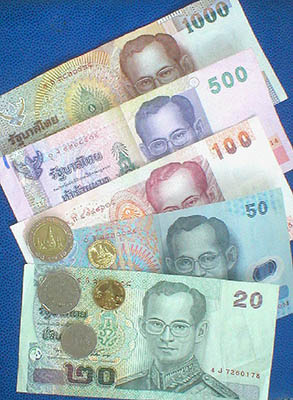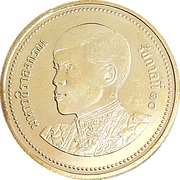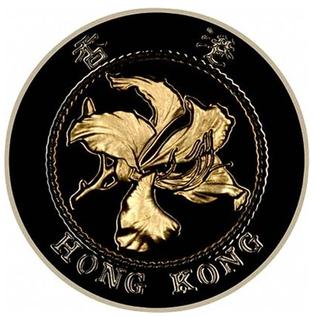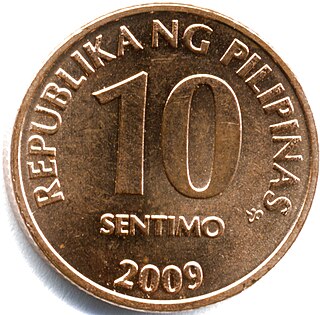
The baht is the official currency of Thailand. It is divided into 100 satang. The issuance of currency is the responsibility of the Bank of Thailand. SWIFT ranked the Thai baht as the 10th-most-frequently used world payment currency as of January 2019.
The khoums is the subdivisory unit of the Mauritanian monetary system, the ouguiya. Five khoums make an ouguiya, hence one khoums can be expressed as 0.2 ouguiya.
The Thailand one-satang coin is a currency unit equivalent to one-hundredth of a Thai baht. It is rare in circulation but used in banking transactions.
The Thailand ten-satang coin is a currency unit equivalent to one-tenth of a Thai baht. It is rare in circulation but used in banking transactions.

The Thailand fifty-satang coin is currency unit equivalent to one-half of a Thai baht. It is also called สองสลึง.

In Thailand, the two-baht coin is the coin which is worth 2 baht or 200 satang. The new 2-baht coin design features H.M. King Bhumibol Adulyadej, the Great on the obverse, like all other Thai legal tender coins presently in circulation. The reverse design depicts the Golden Mountain at Wat Saket Ratcha Wora Maha Wihan in Bangkok.

The one-dollar coin is the fourth-highest and fourth-lowest denomination coin of the Hong Kong dollar.

The twenty-five øre coin was a coin of the Danish krone. It was the lowest-denomination coin in the country when it was demonetised on 1 October 2008.

The ten-dollar coin is the highest-valued circulating coin issued in Hong Kong.
The five dollar coin is the second-highest denomination coin of the Hong Kong dollar. It replaced the five dollar banknotes in 1976.

The twenty-cent coin is a coin of the Hong Kong dollar. It is the second-smallest denomination coin in Hong Kong. There have been two different periods of usage for a twenty-cent coin: the first, round twenty-cent was issued from 1866 to 1905, and the current scallop-shaped coin was introduced in 1975.
The Romanian one-ban coin is a unit of currency equalling one one-hundredth of a Romanian leu. It is the lowest-denomination coin of the present currency and has been minted every year since the leu was redenominated in 2005. As well as Romania, the coin has been minted in the United Kingdom (1867), Germany (1900) and Russia (1952).

The Philippine one-centavo coin (1¢) is the smallest-denomination coin of the Philippine peso. It has been issued since 1903 during American rule. It became the smallest unit of currency following the removal of the half-centavo in 1908.

The Philippine ten-centavo coin (10¢) coin is a denomination of the Philippine peso. It was the oldest denomination under 1 peso in the country's circulation, having been introduced in 1880 during the Spanish rule of the islands until it was stopped being minted in 2017. The denomination is still legal tender until the demonetization of the BSP Coin Series.
The history of Thai money used as a medium of exchange and to settle accounts before the adoption of Thai baht coins and banknotes include novel designs and forms. For Thai people, money was considered as the symbol of civilization. Currency itself reflected faith in religion, culture, the customs and traditions of each era and also serve as a record of the development of Thailand.
The New Zealand two-dollar coin is the largest-denomination coin of the New Zealand dollar. It was introduced along with the one-dollar coin in 1990. Both are made from an alloy of aluminium and brass. It is the largest and heaviest coin in circulation, weighing ten grams and measuring 26.5 millimetres in diameter. Its thickness is 2.7 mm, only 0.4 mm thinner than the one-dollar coin, thus it is the second-thickest coin in the country's circulation. Both the $1 and $2 coins are gold-coloured, and requests for a Koha, donation or entry fee sometimes say gold coin please.
The New Zealand one-cent coin, sometimes informally the penny, was the smallest denomination coin of the New Zealand dollar from the currency's introduction in 1967 to its demonetisation, along with the two-cent coin, on 30 April 1990. With a diameter of 17.53 millimetres, it is the smallest coin ever issued of the dollar, and at 2.07 grams in mass the lightest as well. Its reverse featured a fern leaf, a sign of New Zealand, associated also with its national rugby union team. The image was designed by Reginald George James Berry, who designed the reverses for all coins introduced that year.
The New Zealand fifty-cent coin is a coin of the New Zealand dollar. It was the largest by denomination, diameter and mass to have been introduced on the decimalisation of the currency on 10 July 1967, replacing the pre-decimal crown coin. A total of 81,585,200 pre-2006 50 cent coins were issued, with a total value of $40,792,600.00
The ten-bani coin is a coin of the Romanian leu. It was reintroduced on 1 July 2005 and is the second-largest denomination coin in Romania. In addition to Romania, it has been minted in the United Kingdom (1867), Belgium, Germany (1906) and Russia (1952).
The fifty-bani coin is a coin of the Romanian leu. The fifty-bani is also the only coin of Romania to not be steel-based, but be made completely of an alloy, and was also the first coin in the country to have a written inscription on its edge, with the introduction of 4 new coins in 2019.







